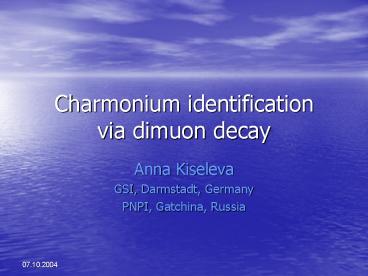Charmonium identification via dimuon decay - PowerPoint PPT Presentation
Charmonium identification via dimuon decay
Methods of invariant mass calculation: superevent. Methods of invariant mass calculation: superevent event ... Use data for another detectors (STS, TRD, ECAL) Study of the ... – PowerPoint PPT presentation
Title: Charmonium identification via dimuon decay
1
Charmonium identification via dimuon decay
- Anna Kiseleva
- GSI, Darmstadt, Germany
- PNPI, Gatchina, Russia
2
Outline
- Setup of the simulations
- Study of the background parameters
- Methods of the invariant mass calculation
- Invariant mass spectrum signal background
- Future steps
3
Setup
- All CBM-detectors
- Framework cbmroot
- Magnetic field FIELD.v04_pavel.map
- Background UrQMD (central AuAu collision at 25
AGeV) - J/Psi signal Pluto
- 1 momentum resolution for the signal
- 100 efficiency and particle identification
4
Geometry
Cave Magnet Target Pipe STS RICH TRD RPC Gas-detec
tor
5
Momentum distribution for the background
6
Momentum distribution for the signal
Momentum distribution for the signal and
background
7
Other parameters of the background
kink angle
opening angle
8
Methods of invariant mass calculation event by
event
9
Methods of invariant mass calculation superevent
10
Methods of invariant mass calculation superevent
event-by-event
11
Invariant mass spectrum (signal background)
J/?
12
To do
- Simulation with tracking reject muons from ? and
K decay - Simulation with muon efficiency of ECAL or muon
detector - Use data for another detectors (STS, TRD, ECAL)
- Study of the parameters for the signal/background
selection
13
Thank you for your attention!
14
Charmonium identification via dimuon decay
- Anna Kiseleva
- GSI, Darmstadt, Germany
- PNPI, Gatchina, Russia
15
?? from ?? and ?? decay into UrQMD events
N/N0 exp(-L/c???)
L 11 m
Pt 1 GeV/c
2 GeV/c
??ct 7.8 m m 139.57 MeV
0.82
0.91
??ct 3.7 m m 493.7 MeV
0.23
0.48
PowerShow.com is a leading presentation sharing website. It has millions of presentations already uploaded and available with 1,000s more being uploaded by its users every day. Whatever your area of interest, here you’ll be able to find and view presentations you’ll love and possibly download. And, best of all, it is completely free and easy to use.
You might even have a presentation you’d like to share with others. If so, just upload it to PowerShow.com. We’ll convert it to an HTML5 slideshow that includes all the media types you’ve already added: audio, video, music, pictures, animations and transition effects. Then you can share it with your target audience as well as PowerShow.com’s millions of monthly visitors. And, again, it’s all free.
About the Developers
PowerShow.com is brought to you by CrystalGraphics, the award-winning developer and market-leading publisher of rich-media enhancement products for presentations. Our product offerings include millions of PowerPoint templates, diagrams, animated 3D characters and more.































